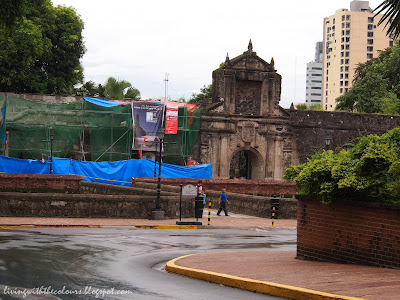 |
| Hello there, Intramuros! |
Fort Santiago-Intramuros is not a new place to us. We've been here before, but we were in a rush. Mainly because we got LOST. Most of our time was spent in walking and looking for Fort Santiago.
If you're into historical and vintage places, it will be worth the walk. For us, it was worth the revisit.
The walled part of Manila was called Intramuros, which is Latin for "within the walls". These walls were originally built as defensive walls from foreign invasions by the Spanish colonial government in the late 16th century. Although the place underwent several damages and reconstruction, it is still a good place to visit and relive Philippines' history.
This time we were accompanied by Charlene who is always ready to strike a pose whenever we ask her to.
 |
| Picture worth a thousand likes! |
In order to reach Fort Santiago, we had to walk within the walls of Intramuros.
 |
| Walking around with the sisters. |
The roads & establishments were vintage-themed. We saw old Filipino houses with Capiz windows, old mode of transportation (kalesa), and old street signs. Even the guards were wearing vintage-style uniforms. It was like walking in Philippines' memory lane.
 |
| This is the vintage uniform with a vintage pose! |
 |
| Even the street signs are vintage. |
 |
| Enjoying the nature. |
 |
| Kalesa bay. |
 |
| Manila Cathedral's Bell Tower |
 |
| Manila Cathedral, Intramuros. |
Foreigners, mostly Koreans, were also enjoying their trip in Intramuros and Fort Santiago.
You know that you love your job when you're enjoying doing it just like these guys.
Moog ng Santiago or Fort Santiago is one of the most important historical places in the Philippines. This is where Gat. Jose Rizal was imprisoned because of rebellion against the Spanish Government.
 |
| Entrance of Fort Santiago. |
 |
| Main gate of Fort Santiago. |
 |
| Cannon and shells inside Fort Santiago. |
 |
| You can also grab a kalesa to roam around Fort Santiago. |
 |
| Spanish-era cannon with kuyang kutchero. |
Gat. Jose Rizal was imprisoned in Fort Santiago from November 3, 1896 to December 30, 1896.
According to history books, it took Rizal 13,256 steps to reach Luneta.
 |
| Rizal's last footsteps before his execution in Luneta. |
 |
| Statue of Gat. Jose Rizal in the middle of Fort Santiago. |
The Rizal Shrine Museum preserved some items from the Spanish-era and Jose Rizal's memorabilias.
 |
| In front of Rizal Shrine Museum. |
 |
| A view of Pasig river in Falsabraga de Media Naranja of Fort Santiago. Just outside the Rizal Shrine Museum. |
Gat. Jose Rizal is considered as the national hero of the Philippines because of his determination to fight for our freedom through a peaceful & diplomatic way.
Special thanks to our model, Charlene Manalang. 'til next time!
Walking within these walls was like walking with the piece of history.
--------------------------------------------------------------------------------------
Additional Info:
Cost; Fort Santiago has an entrance fee of P75.00 while Intramuros is free.
How to get there:
1. Take the LRT1 to Central terminal station.
2. Just walk until you reach Natividad Almeda-Lopez
3. Turn right at Natividad Almeda-Lopez and walk past Padre Burgos Avenue.
4. After crossing Padre Burgos Avenue you'll see the entrance of Intramuros.
If you are a photowalker like us, this is a great place to practice your photography skills.
















